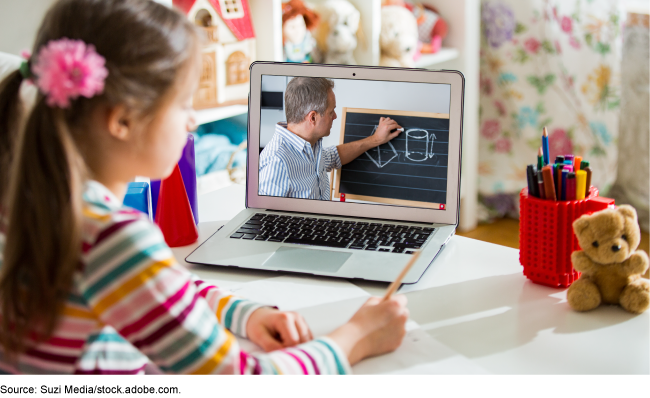Pandemic Learning: As Students Struggled to Learn, Teachers Reported Few Strategies as Particularly Helpful to Mitigate Learning Loss
Fast Facts
The COVID-19 pandemic disrupted learning for millions of students and educators across the U.S. during the 2020-21 school year.
We surveyed K-12 public school teachers nationwide and found:
- 60% of virtual learning teachers said their students had more difficulty understanding lessons than in a typical school year
- 61% of all teachers had more students who experienced emotional distress than in a typical year
- 85% of in-person teachers said live instruction, fully or partially in-person, helped students
- Fewer than 40% of all teachers thought asynchronous learning, in which students work independently, helped the majority of their students

Note: The survey link was updated because the previous link was incorrect.
Highlights
What GAO Found
During the 2020-21 school year, students in all grade levels, whether learning in person or virtually, struggled with many obstacles. These ranged from lack of appropriate workspaces and adequate support to competing demands on their time, disengagement, and absences. Such obstacles hindered student learning, according to GAO's nationwide survey of K-12 public school teachers and discussion groups with teachers, principals, and parents (see figure).

In particular, a higher percentage of teachers who taught students in virtual or hybrid (mix of virtual and in-person) environments consistently reported that their students experienced learning difficulties than teachers in an in-person environment. For example, an estimated 60 percent of teachers in a virtual environment had students who had more difficulty understanding lessons than in a typical year, compared to 37 percent of teachers in an in-person environment. Differences in the responses between virtual and in-person environments could reflect the instructional setting and other factors that GAO did not measure, such as school resources or certain student characteristics. In addition, obstacles affecting students varied by grade level. For example, 92 percent of grades 9-12 teachers who had students who made less academic progress compared to a typical year indicated that social or emotional issues were contributors compared to 83 percent of grades 3-8 teachers and 69 percent of K-2 teachers.
Teachers used many strategies to mitigate learning loss. They reported that two strategies in particular helped at least half their students make academic progress: live instruction and technology apps or platforms. Specifically, 85 percent of teachers who taught students fully or partially in person indicated that live instruction helped many of their students. In contrast, 56 percent of teachers who taught students virtually all or part of the time indicated that live virtual instruction (i.e., synchronous learning) helped many of their students. Regarding technology, nearly two-thirds of teachers who used apps or platforms for students to submit their assignments and to provide feedback thought it was helpful for many of their students. Teachers used many other strategies as well, but they were generally helpful to fewer students and used less often. One notable exception was asynchronous learning, in which students work independently without live instruction. This strategy was used regularly by 69 percent of teachers, yet fewer than 40 percent thought it helped at least half of their students.
Why GAO Did This Study
The COVID-19 pandemic disrupted learning for millions of students, educators, and families who had to navigate modified in-person and virtual schooling, often in difficult circumstances. The pandemic's effects continue to reverberate across the nation and produce challenges for schools that will likely be felt for years to come. In many respects, the 2020-21 school year offered useful insights that may help schools, educators, and parents in the future.
The CARES Act includes a provision for GAO to report on its ongoing COVID-19 monitoring and oversight efforts. GAO also conducted this work in response to a provision in the conference report accompanying the National Defense Authorization Act of Fiscal Year 2021. This report, which is the first in a series of reports, examines (1) obstacles to learning during school year 2020-21, and (2) strategies to mitigate learning loss. GAO examines these topics overall, by grade level, and by instructional model (in-person, virtual, or hybrid).
To address these objectives, GAO contracted with Gallup to (1) conduct a nationally representative survey of K-12 public school teachers and (2) arrange virtual discussion groups with teachers, principals, and parents of K-12 students. GAO also held two additional discussion groups, one with teachers and one with parents of students in Department of Defense Education Activity schools. GAO analyzed the resulting survey data and discussion group responses. To view more technical details on GAO's methods, see https://www.gao.gov/products/GAO-22-105817.
For more information, contact Jacqueline M. Nowicki at (617) 788-0580 or nowickij@gao.gov.
